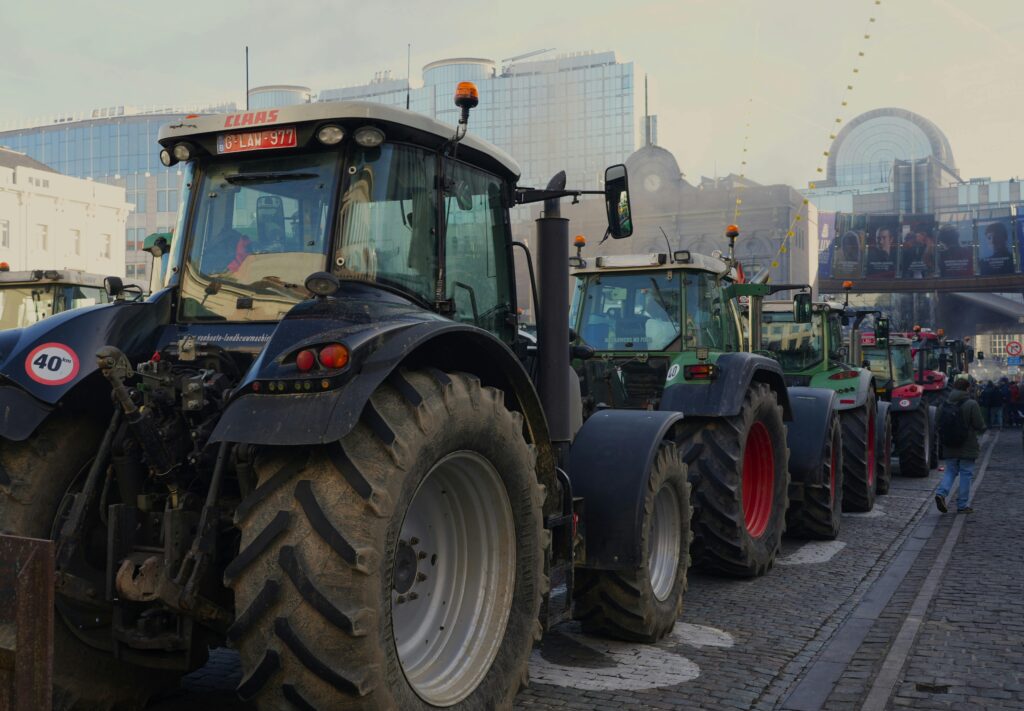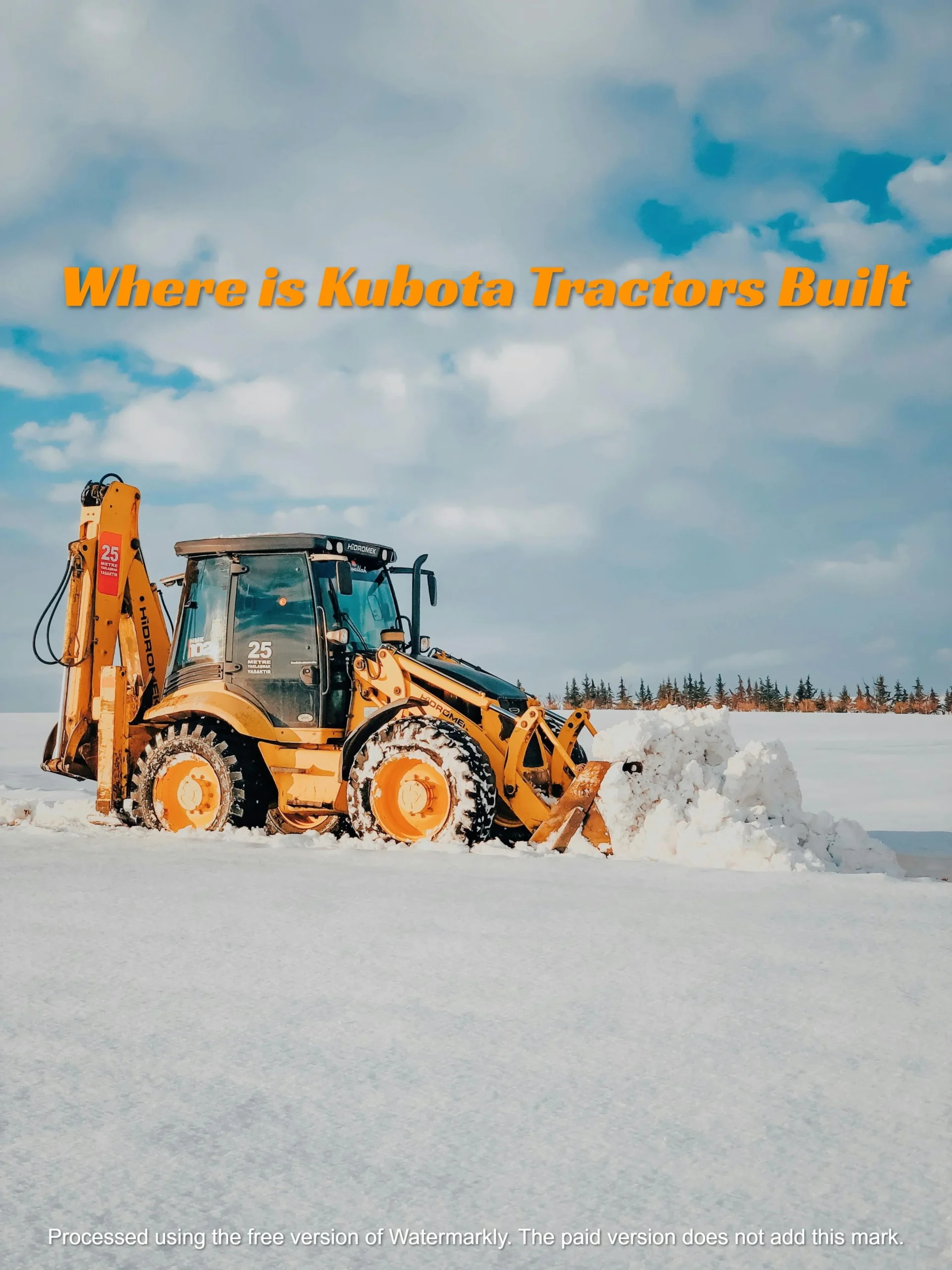Kubota tractors are primarily manufactured in Japan and the United States. The company’s main production facilities are located in Japan, with additional manufacturing plants in the United States to cater to the North American market. Kubota is known for its high-quality compact and utility tractors, which are widely used in agriculture, landscaping, and construction industries worldwide.
Introduction
Kubota Corporation is a Japanese multinational corporation based in Osaka, Japan. Founded in 1890, the company has grown to become a global leader in the manufacturing of various types of machinery, including tractors, construction equipment, and engines. Kubota’s tractors, in particular, have gained a reputation for their durability, reliability, and innovative features, making them a popular choice among farmers, landscapers, and construction professionals worldwide.
As the demand for Kubota tractors continues to rise, many consumers are curious about where these machines are built and the processes involved in their production. In this comprehensive article, we will explore the various locations where Kubota tractors are manufactured, the company’s commitment to quality, and the factors that contribute to the exceptional performance of these machines.
Kubota’s Global Manufacturing Footprint
Kubota Corporation has established a global manufacturing network to meet the growing demand for its products across different regions. While the company’s headquarters and primary manufacturing facilities are located in Japan, Kubota has strategically expanded its operations to other countries to better serve its customers and streamline its supply chain.
Japan: The Heart of Kubota’s Manufacturing
Japan remains the epicenter of Kubota’s tractor production, with several manufacturing plants located throughout the country. The company’s main tractor assembly plant is situated in Sakai City, Osaka Prefecture, where many of its iconic tractor models, such as the M-Series and L-Series, are produced.
| Plant Location | Models Produced |
|---|---|
| Sakai City, Osaka Prefecture | M-Series, L-Series, and select compact models |
| Tsukuba City, Ibaraki Prefecture | Compact tractor models and utility vehicles |
| Osaka Plant, Osaka Prefecture | Engines and tractor components |
In addition to these primary facilities, Kubota has several other plants across Japan that contribute to the production of tractor components, engines, and other parts essential for the assembly process.
United States: Catering to the North American Market
To better serve the North American market, Kubota has established manufacturing operations in the United States. The company’s tractor production facility is located in Gainesville, Georgia, where a range of compact and utility tractors are assembled.
| Plant Location | Models Produced |
|---|---|
| Gainesville, Georgia | Compact and utility tractor models |
The Gainesville plant plays a crucial role in meeting the demands of the North American market, which has a strong agricultural and landscaping presence. By manufacturing tractors locally, Kubota can ensure faster delivery times, streamlined logistics, and better customer support for its North American customers.
France: Serving the European Market
To cater to the European market, Kubota has a tractor manufacturing facility in Bierne, France. This plant specializes in the production of a wide range of compact and utility tractor models designed to meet the specific needs of European farmers and landscapers.
| Plant Location | Models Produced |
|---|---|
| Bierne, France | Compact and utility tractor models for European markets |
The Bierne plant not only serves the European market but also exports tractors to other regions, contributing to Kubota’s global presence and expanding customer base.
Thailand: A Hub for Southeast Asian Markets
Recognizing the growing demand for agricultural machinery in Southeast Asia, Kubota has established a manufacturing facility in Amata Nakorn Industrial Estate, Thailand. This plant primarily focuses on the production of compact and utility tractor models tailored to the needs of the Southeast Asian market.
| Plant Location | Models Produced |
|---|---|
| Amata Nakorn Industrial Estate, Thailand | Compact and utility tractor models for Southeast Asian markets |
By having a manufacturing presence in Thailand, Kubota can better cater to the unique requirements of the Southeast Asian agricultural sector while benefiting from the region’s favorable trade agreements and strategic location.
Kubota’s Commitment to Quality and Innovation
Regardless of the location where Kubota tractors are built, the company upholds stringent quality standards and continuously invests in research and development to ensure its products remain at the forefront of innovation.
Quality Assurance and Testing
Kubota’s manufacturing processes are governed by rigorous quality control measures, ensuring that every tractor that rolls off the assembly line meets the highest standards of performance, durability, and safety. The company employs a variety of testing methods, including simulations, accelerated life testing, and field trials, to evaluate the tractors’ performance under diverse conditions and environments.
Cutting-Edge Engineering and Design
Kubota’s success can be attributed to its unwavering commitment to innovation and continuous product improvement. The company’s team of engineers and designers collaborate closely to develop new technologies and features that enhance the tractors’ efficiency, versatility, and user experience.
From advanced hydraulic systems and ergonomic operator stations to precision farming technologies and intelligent control systems, Kubota remains at the forefront of tractor innovation, constantly pushing the boundaries of what these machines can achieve.
Sustainable Manufacturing Practices
In addition to its focus on quality and innovation, Kubota is dedicated to sustainable manufacturing practices that minimize its environmental impact. The company has implemented various initiatives to reduce energy consumption, water usage, and waste generation across its manufacturing facilities.
Kubota also prioritizes the use of environmentally friendly materials and processes, ensuring that its tractors not only deliver exceptional performance but also contribute to a more sustainable future for agriculture and landscaping.
The Factors that Make Kubota Tractors Stand Out
Kubota’s tractors are renowned for their exceptional performance, durability, and versatility, making them a preferred choice among professionals and enthusiasts alike. Several key factors contribute to the success and popularity of these machines.
Robust and Reliable Design
Kubota tractors are designed to withstand the rigors of demanding agricultural and landscaping tasks. The company’s engineers meticulously select high-quality materials and implement robust construction techniques to ensure that each tractor can withstand harsh environments, heavy loads, and prolonged use.
From the sturdy chassis and reinforced hitches to the durable hydraulic systems and reliable transmissions, every component of a Kubota tractor is built to last, minimizing downtime and maximizing productivity.
Versatility and Adaptability
One of the defining characteristics of Kubota tractors is their versatility. These machines are designed to tackle a wide range of tasks, from tilling and plowing to hauling and material handling. Kubota offers a vast array of attachments and implements that can be seamlessly integrated with their tractors, allowing users to customize their machines for specific applications.
Whether you’re working on a farm, a construction site, or a landscaping project, Kubota tractors can be adapted to meet your unique needs, providing unparalleled flexibility and efficiency.

Operator Comfort and Ergonomics
Kubota understands that operator comfort and ergonomics play a critical role in productivity and safety. The company’s tractors feature well-designed operator stations with optimized visibility, intuitive controls, and adjustable seating arrangements.
Kubota’s engineers prioritize factors such as vibration reduction, noise insulation, and ease of operation, ensuring that operators can work comfortably for extended periods without experiencing fatigue or discomfort.
Global Support and Service Network
Kubota’s success is also driven by its extensive global support and service network. The company has established dealerships and service centers across the globe, ensuring that customers can access genuine parts, expert technicians, and prompt maintenance services wherever they operate their Kubota tractors.
This commitment to customer support not only ensures the longevity and optimal performance of Kubota’s tractors but also fosters long-lasting relationships with its customers, further solidifying the company’s reputation for excellence.
Kubota’s Commitment to Continuous Improvement
Kubota’s success is not only attributed to its current manufacturing processes and product offerings but also to its unwavering commitment to continuous improvement. The company constantly seeks feedback from customers, dealers, and industry experts to identify areas for enhancement and innovation.
Kubota values the insights and experiences of its customer base, as they are the ones who directly interact with the tractors on a daily basis. The company actively collects feedback through various channels, including customer surveys, focus groups, and direct communication with dealerships and service centers.
Incorporating User Feedback
This valuable input helps Kubota’s engineers and designers identify potential areas for improvement, such as ergonomic enhancements, user interface refinements, or the development of new features and attachments that can further increase productivity and efficiency.
Collaborating with Industry Partners
In addition to user feedback, Kubota actively collaborates with industry partners, including agricultural organizations, research institutions, and technology companies. These collaborations enable Kubota to stay ahead of emerging trends, gain insights into new technologies, and explore innovative solutions that can be integrated into their tractor designs.
By working closely with industry partners, Kubota can anticipate and address the evolving needs of the agriculture and landscaping sectors, ensuring that its products remain relevant and at the forefront of innovation.
Investing in Research and Development
Kubota recognizes the importance of continuous research and development in maintaining its competitive edge. The company actively invests in state-of-the-art research facilities and employs a team of highly skilled engineers, scientists, and designers dedicated to pushing the boundaries of tractor technology.
From exploring alternative fuel sources and advanced propulsion systems to developing intelligent farming solutions and autonomous capabilities, Kubota’s research and development efforts aim to create tractors that are not only more efficient and productive but also environmentally sustainable and future-ready.
Through its commitment to continuous improvement, Kubota ensures that its manufacturing processes, product offerings, and customer support remain unparalleled, solidifying its position as a global leader in the tractor industry.

Conclusion
Kubota’s tractors are built with meticulous attention to detail and unwavering commitment to quality, innovation, and customer satisfaction. From the company’s primary manufacturing facilities in Japan to its strategic plants around the world, each Kubota tractor embodies the brand’s core values of durability, reliability, and performance.
Whether you’re a professional farmer, landscaper, or construction worker, Kubota’s global manufacturing footprint ensures that you have access to a tractor that meets your specific needs and exceeds your expectations. With a relentless pursuit of excellence and a dedication to sustainable practices, Kubota continues to set the standard for tractor manufacturing, empowering individuals and businesses across diverse industries to achieve more with every turn of the wheel.
FAQs
Q1: Where is Kubota’s main tractor manufacturing facility located?
A1: Kubota’s primary tractor assembly plant is located in Sakai City, Osaka Prefecture, Japan. This facility is responsible for producing many of Kubota’s iconic tractor models, including the M-Series and L-Series.
Q2: Does Kubota manufacture tractors exclusively in Japan?
A2: No, Kubota has established manufacturing facilities in several other countries to better serve regional markets. The company has tractor production plants in the United States (Gainesville, Georgia), France (Bierne), and Thailand (Amata Nakorn Industrial Estate).
Q3: What quality control measures does Kubota implement in its manufacturing processes?
A3: Kubota employs rigorous quality assurance and testing procedures to ensure that every tractor meets the highest standards of performance, durability, and safety. These measures include simulations, accelerated life testing, field trials, and stringent inspections throughout the assembly process.
Q4: How does Kubota prioritize sustainability in its manufacturing operations?
A4: Kubota is committed to sustainable manufacturing practices that minimize its environmental impact. The company has implemented initiatives to reduce energy consumption, water usage, and waste generation across its facilities. Additionally, Kubota prioritizes the use of environmentally friendly materials and processes in the production of its tractors.
Q5: What sets Kubota tractors apart from competitors in terms of performance and versatility?
A5: Kubota tractors are renowned for their robust and reliable design, built to withstand demanding agricultural and landscaping tasks. They are also highly versatile, with a vast array of attachments and implements that can be seamlessly integrated, allowing users to customize their machines for specific applications. Kubota’s commitment to operator comfort and ergonomics further enhances productivity and safety.

